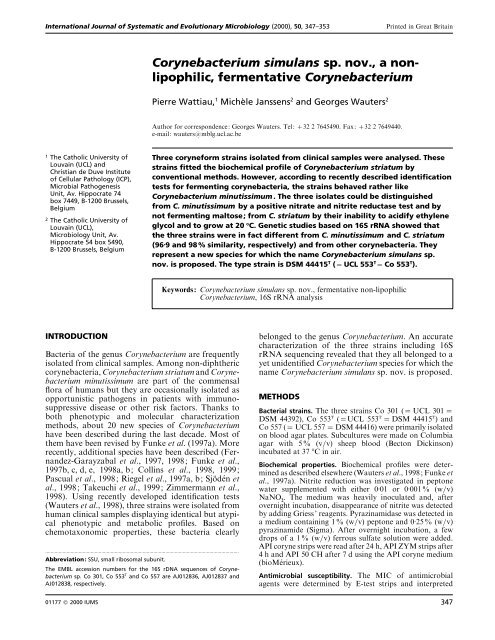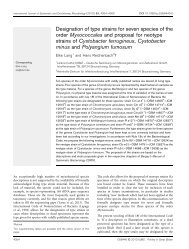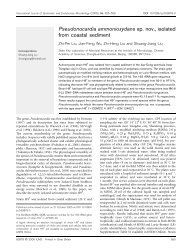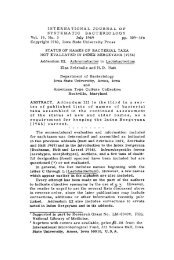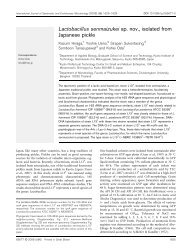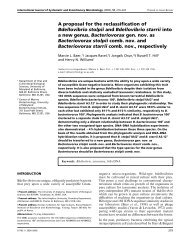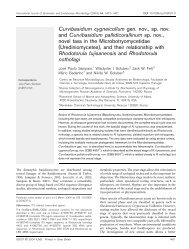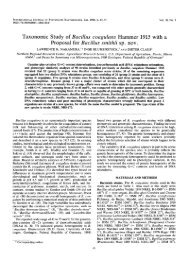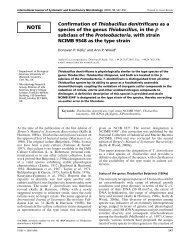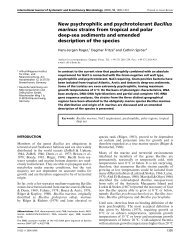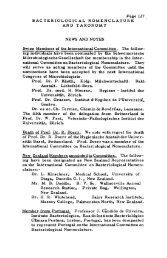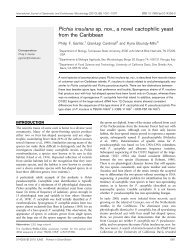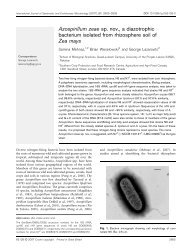Corynebacterium simulans sp. nov., a non - International Journal of ...
Corynebacterium simulans sp. nov., a non - International Journal of ...
Corynebacterium simulans sp. nov., a non - International Journal of ...
Create successful ePaper yourself
Turn your PDF publications into a flip-book with our unique Google optimized e-Paper software.
<strong>International</strong> <strong>Journal</strong> <strong>of</strong> Systematic and Evolutionary Microbiology (2000), 50, 347–353<br />
Printed in Great Britain<br />
<strong>Corynebacterium</strong> <strong>simulans</strong> <strong>sp</strong>. <strong>nov</strong>., a <strong>non</strong>lipophilic,<br />
fermentative <strong>Corynebacterium</strong><br />
Pierre Wattiau, 1 Miche le Janssens 2 and Georges Wauters 2<br />
Author for corre<strong>sp</strong>ondence: Georges Wauters. Tel: 32 2 7645490. Fax: 32 2 7649440.<br />
e-mail: wautersmblg.ucl.ac.be<br />
1 The Catholic University <strong>of</strong><br />
Louvain (UCL) and<br />
Christian de Duve Institute<br />
<strong>of</strong> Cellular Pathology (ICP),<br />
Microbial Pathogenesis<br />
Unit, Av. Hippocrate 74<br />
box 7449, B-1200 Brussels,<br />
Belgium<br />
2 The Catholic University <strong>of</strong><br />
Louvain (UCL),<br />
Microbiology Unit, Av.<br />
Hippocrate 54 box 5490,<br />
B-1200 Brussels, Belgium<br />
Three coryneform strains isolated from clinical samples were analysed. These<br />
strains fitted the biochemical pr<strong>of</strong>ile <strong>of</strong> <strong>Corynebacterium</strong> striatum by<br />
conventional methods. However, according to recently described identification<br />
tests for fermenting corynebacteria, the strains behaved rather like<br />
<strong>Corynebacterium</strong> minutissimum . The three isolates could be distinguished<br />
from C. minutissimum by a positive nitrate and nitrite reductase test and by<br />
not fermenting maltose; from C. striatum by their inability to acidify ethylene<br />
glycol and to grow at 20 SC. Genetic studies based on 16S rRNA showed that<br />
the three strains were in fact different from C. minutissimum and C. striatum<br />
(969 and 98% similarity, re<strong>sp</strong>ectively) and from other corynebacteria. They<br />
represent a new <strong>sp</strong>ecies for which the name <strong>Corynebacterium</strong> <strong>simulans</strong> <strong>sp</strong>.<br />
<strong>nov</strong>. is proposed. The type strain is DSM 44415 T ( UCL 553 T Co 553 T ).<br />
Keywords: <strong>Corynebacterium</strong> <strong>simulans</strong> <strong>sp</strong>. <strong>nov</strong>., fermentative <strong>non</strong>-lipophilic<br />
<strong>Corynebacterium</strong>, 16S rRNA analysis<br />
INTRODUCTION<br />
Bacteria <strong>of</strong> the genus <strong>Corynebacterium</strong> are frequently<br />
isolated from clinical samples. Among <strong>non</strong>-diphtheric<br />
corynebacteria, <strong>Corynebacterium</strong> striatum and <strong>Corynebacterium</strong><br />
minutissimum are part <strong>of</strong> the commensal<br />
flora <strong>of</strong> humans but they are occasionally isolated as<br />
opportunistic pathogens in patients with immunosuppressive<br />
disease or other risk factors. Thanks to<br />
both phenotypic and molecular characterization<br />
methods, about 20 new <strong>sp</strong>ecies <strong>of</strong> <strong>Corynebacterium</strong><br />
have been described during the last decade. Most <strong>of</strong><br />
them have been revised by Funke et al. (1997a). More<br />
recently, additional <strong>sp</strong>ecies have been described (Fernandez-Garayzabal<br />
et al., 1997, 1998; Funke et al.,<br />
1997b, c, d, e, 1998a, b; Collins et al., 1998, 1999;<br />
Pascual et al., 1998; Riegel et al., 1997a, b; Sjo de n et<br />
al., 1998; Takeuchi et al., 1999; Zimmermann et al.,<br />
1998). Using recently developed identification tests<br />
(Wauters et al., 1998), three strains were isolated from<br />
human clinical samples di<strong>sp</strong>laying identical but atypical<br />
phenotypic and metabolic pr<strong>of</strong>iles. Based on<br />
chemotaxonomic properties, these bacteria clearly<br />
.................................................................................................................................................<br />
Abbreviation : SSU, small ribosomal subunit.<br />
The EMBL accession numbers for the 16S rDNA sequences <strong>of</strong> <strong>Corynebacterium</strong><br />
<strong>sp</strong>. Co 301, Co 553 T and Co 557 are AJ012836, AJ012837 and<br />
AJ012838, re<strong>sp</strong>ectively.<br />
belonged to the genus <strong>Corynebacterium</strong>. An accurate<br />
characterization <strong>of</strong> the three strains including 16S<br />
rRNA sequencing revealed that they all belonged to a<br />
yet unidentified <strong>Corynebacterium</strong> <strong>sp</strong>ecies for which the<br />
name <strong>Corynebacterium</strong> <strong>simulans</strong> <strong>sp</strong>. <strong>nov</strong>. is proposed.<br />
METHODS<br />
Bacterial strains. The three strains Co 301 ( UCL 301 <br />
DSM 44392), Co 553T (UCL 553T DSM 44415T) and<br />
Co 557 ( UCL 557 DSM 44416) were primarily isolated<br />
on blood agar plates. Subcultures were made on Columbia<br />
agar with 5% (vv) sheep blood (Becton Dickinson)<br />
incubated at 37 C in air.<br />
Biochemical properties. Biochemical pr<strong>of</strong>iles were determined<br />
as described elsewhere (Wauters et al., 1998; Funke et<br />
al., 1997a). Nitrite reduction was investigated in peptone<br />
water supplemented with either 001 or 0001% (wv)<br />
NaNO 2<br />
. The medium was heavily inoculated and, after<br />
overnight incubation, disappearance <strong>of</strong> nitrite was detected<br />
by adding Griess’ reagents. Pyrazinamidase was detected in<br />
a medium containing 1% (wv) peptone and 025% (wv)<br />
pyrazinamide (Sigma). After overnight incubation, a few<br />
drops <strong>of</strong> a 1% (wv) ferrous sulfate solution were added.<br />
API coryne strips were read after 24 h, API ZYM strips after<br />
4 h and API 50 CH after 7 d using the API coryne medium<br />
(bioMe rieux).<br />
Antimicrobial susceptibility. The MIC <strong>of</strong> antimicrobial<br />
agents were determined by E-test strips and interpreted<br />
01177 2000 IUMS 347
P. Wattiau, M. Janssens and G. Wauters<br />
according to criteria established for staphylococci by the<br />
National Committee for Clinical Laboratory Standards<br />
(1997).<br />
Chemotaxonomic studies. Cellular fatty acid composition<br />
was determined by GLC using a Delsi DI 200 chromatograph<br />
(Intersmat) as described elsewhere (Wauters et al.,<br />
1996). Mycolic acids were detected by TLC (Minnikin et al.,<br />
1980). Peptidoglycan analysis was performed by N. Weiss at<br />
DSMZ (Deutsche Sammlung von Mikroorganismen und<br />
Zellkulturen, Braunschweig, Germany), using a TLC<br />
method (Schleifer & Kandler, 1972). Cell wall sugars were<br />
determined as alditol acetates by GC (Saddler et al., 1991) by<br />
P. Schumann at the DSMZ.<br />
DNA preparation, restriction and sequencing. Total DNA<br />
from strains Co 301, Co 553T and Co 557 was prepared<br />
according to the method <strong>of</strong> Marmur (1961) except that cells<br />
were disrupted by sonification rather than by lysozyme<br />
treatment. A 15 kb PCR fragment corre<strong>sp</strong>onding to the 16S<br />
rDNA was generated with the Dynazyme thermostable<br />
polymerase (Finnzymes) using the 16S rDNA PCR primers<br />
‘27F’ and ‘1522R’ (Johnson, 1994) according to the<br />
following PCR protocol: 95 C for 30 s, 55 C for 30 s and<br />
72 C for 60 s (30 cycles). Sequencing reactions were obtained<br />
directly on ethanol-precipitated PCR products with<br />
the Thermosequenase kit (Amersham) using P-labelled<br />
oligonucleotides as sequencing primers. The universal forward<br />
and reverse 16S rDNA sequencing primers 321, 530,<br />
685, 1100, 1242 and 1392, numbered relative to the<br />
Escherichia coli 16S rRNA numbering, were used in this<br />
study (Johnson, 1994). The sequencing reactions were<br />
analysed by electrophoresis on 6% (wv) acrylamide, 8 M<br />
urea sequencing gels on a Macrophor unit (Pharmacia).<br />
Restriction analysis was assayed by incubating approximately<br />
01 µg ethanol-precipitated, PCR-amplified DNA<br />
with the relevant restriction enzyme in a buffer supplied by<br />
the manufacturer (Pharmacia). The restricted DNA was<br />
separated on a 15% (wv) agarose gel by electrophoresis at<br />
constant voltage in TBE buffer (Tris 05 M, boric acid 05 M<br />
and EDTA 10 mM, pH 83) together with a molecular<br />
weight standard (Life Technologies) and stained with<br />
ethidium bromide.<br />
Nucleotide sequence comparison and phylogenetic analysis.<br />
The FASTA s<strong>of</strong>tware was used for DNA homology<br />
searches (Pearson & Lipman, 1988). When available, prealigned<br />
16S rDNA sequences from other <strong>Corynebacterium</strong><br />
<strong>sp</strong>ecies were retrieved from the small ribosomal subunit<br />
(SSU) RNA database (Van de Peer et al., 1998) and aligned<br />
with the newly determined sequences. 16S rDNA sequences<br />
not found in the SSU RNA database were retrieved from the<br />
EMBL and Genbank databases and aligned manually with<br />
the pre-aligned sequences. Multiple sequence alignments<br />
were generated manually and approximately 100 bases at the<br />
5 end <strong>of</strong> the molecule were removed to avoid alignment<br />
uncertainties due to hypervariable domain V1. The multiple<br />
alignment encompassed nucleotides 122–1361 relative to the<br />
E. coli 16S rRNA numbering. Phylogenetic tree data were<br />
calculated using the PAUPSEARCH s<strong>of</strong>tware (Sw<strong>of</strong>ford, 1990)<br />
run on a SUN Enterprise 450 workstation. The neighbourjoining,<br />
maximum-likelihood and parsimony methods <strong>of</strong><br />
tree construction were applied on the aligned sequences. The<br />
Kimura two-parameter distance correction method was used<br />
for calculating the neighbour-joining tree. Branches that<br />
were found by all the three methods were considered relevant<br />
and validated by a bootstrap analysis (1500 replications)<br />
using PAUPSEARCH. The RETREE and DRAWGRAM programs<br />
from the PHYLIP s<strong>of</strong>tware package version 3.5 (Felsenstein,<br />
1989) were used to manipulate and draw the phylogenetic<br />
trees generated by PAUPSEARCH.<br />
RESULTS AND DISCUSSION<br />
Strains Co 301, Co 553T and Co 557 were isolated from<br />
a foot abscess, a biopsy <strong>of</strong> an axillar lymph node and<br />
a boil, re<strong>sp</strong>ectively. Although the first isolate grew in<br />
pure culture from deep-sited pus, disease association<br />
was not proved and a possible pathogenic role <strong>of</strong> such<br />
strains remains to be established.<br />
On Columbia blood agar, colonies were about 05–<br />
10 mm in diameter after 24 h <strong>of</strong> incubation in air at<br />
37 C and 1–2 mm after 48 h. They were greyish-white,<br />
opaque and glistening, similar to colonies <strong>of</strong> C.<br />
striatum and C. minutissimum. The strains were not<br />
lipophilic. Growth was facultatively anaerobic but was<br />
enhanced in air. Gram stain showed Gram-positive<br />
rods with a typical diphtheroid arrangement.<br />
Biochemical characterization by conventional methods<br />
yielded a pr<strong>of</strong>ile close to that <strong>of</strong> C. striatum (Wauters<br />
et al., 1998; Funke et al., 1997a). The strains were<br />
catalase-positive, <strong>non</strong>-motile and fermentative. Nitrate<br />
reduction was positive, urease was negative.<br />
Pyrazinamidase was positive in two strains and negative<br />
in one. Glucose and sucrose were fermented but<br />
not maltose and mannitol. Tyrosinase and Tween<br />
esterase were positive. The CAMP (Christie–Atkins–<br />
Munch–Petersen) reaction was negative. The three<br />
strains di<strong>sp</strong>layed strong nitrite reduction in nitrite<br />
broths with both low and high concentrations. Nitritereducing<br />
strains have been described in organisms<br />
resembling C. striatum (Markowitz & Coudron, 1990).<br />
In our experience, most strains <strong>of</strong> C. striatum reduce<br />
nitrite at the lower concentration <strong>of</strong> 0001% but not at<br />
001%. A few strains (including the type strain) do not<br />
reduce nitrite at either concentration and a few others<br />
are strong reducers even at 001% (unpublished data).<br />
The numerical code obtained with the API CORYNE<br />
system (V2-0) was 2100305 for strain Co 553T. According<br />
to the manufacturer, this code corre<strong>sp</strong>onds to<br />
<strong>Corynebacterium</strong> ‘CDC group G’ and C. striatum<br />
<strong>Corynebacterium</strong> amycolatum with a confidence level<br />
<strong>of</strong> 870% and 107%, re<strong>sp</strong>ectively. For strain Co 557,<br />
the code was 0100305 which corre<strong>sp</strong>onds to <strong>Corynebacterium</strong><br />
macginleyi, ‘CDC group G’ and C.<br />
striatumC. amycolatum with confidence levels <strong>of</strong><br />
844%, 11% and 27%, re<strong>sp</strong>ectively. For strain Co<br />
301, the code was 2100105 corre<strong>sp</strong>onding to C.<br />
striatumC. amycolatum with a confidence level <strong>of</strong><br />
887%. However, upon addition <strong>of</strong> zinc dust after<br />
reagents for nitrate reduction, as recommended for the<br />
API 20NE strips, it appeared that the nitrate reduction<br />
was falsely negative because <strong>of</strong> the strong nitrite<br />
reduction. After correction <strong>of</strong> the nitrate result, the<br />
numerical codes <strong>of</strong> the three strains became 3100305<br />
(<strong>Corynebacterium</strong> ‘CDC group G’ 550%, C. striatumC.<br />
amycolatum 430%), 1100305 (C. macginleyi<br />
994%) and 3100105 (C. striatumC. amycolatum<br />
985%), re<strong>sp</strong>ectively.<br />
348 <strong>International</strong> <strong>Journal</strong> <strong>of</strong> Systematic and Evolutionary Microbiology 50
<strong>Corynebacterium</strong> <strong>simulans</strong> <strong>sp</strong>. <strong>nov</strong>.<br />
Table 1. Distinctive characters <strong>of</strong> C. <strong>simulans</strong> and related <strong>non</strong>lipophilic fermentative<br />
corynebacteria<br />
.....................................................................................................................................................................................................................................<br />
NO <br />
, nitrate reduction; NO <br />
, nitrite reduction; Ur, urease; Pyz, pyrazinamidase; Suc, sucrose<br />
fermentation; Mal, maltose fermentation; Gal, galactose fermentation; CAMP, CAMP test;<br />
E Gl, acid production from ethylene glycol; 20 C, growth at 20 C; 42 C, glucose fermentation<br />
at 42 C; Form, formate alkalinization; v, variable.<br />
NO 3<br />
NO 2<br />
Ur Pyz Suc Mal Gal CAMP E Gl 20 C 42 C Form<br />
C. <strong>simulans</strong> V V V <br />
C. striatum V V V <br />
C. minutissimum V V <br />
C. singulare <br />
C. amycolatum V V V V V V <br />
C. xerosis V V V <br />
The enzymic pr<strong>of</strong>ile obtained after 4 h incubation with<br />
the API ZYM strips was as follows: alkaline pho<strong>sp</strong>hatase,<br />
esterase, esterase-lipase, leucine arylamidase,<br />
trypsin and naphthol-AS-BI-pho<strong>sp</strong>hohydrolase were<br />
positive. Lipase, valine arylamidase, cystine arylamidase,<br />
chymotrypsin, acid pho<strong>sp</strong>hatase, α- and β-<br />
galactosidase, β-glucuronidase, α- and β-glucosidase,<br />
N-acetyl-β-glucosaminidase, α-mannosidase and α-<br />
fucosidase were negative. By testing sugar fermentations<br />
with 50 CH strips, the three strains were<br />
positive for glucose, fructose, mannose and sucrose<br />
within 24 h. Ribose and N-acetyl-glucosamine were<br />
positive in two strains. Using 50 CH strips, a positive<br />
reaction for galactose fermentation was observed, but<br />
the reaction was sometimes delayed; by conventional<br />
methods, galactose fermentation was sometimes delayed<br />
or the reaction was negative.<br />
With re<strong>sp</strong>ect to the tests recently described for the<br />
identification <strong>of</strong> fermenting corynebacteria (Wauters<br />
et al., 1998), the three strains showed strong alkalinization<br />
<strong>of</strong> formate, like C. striatum and C. minutissimum.<br />
Glucose fermentation at 42 C was variable.<br />
Ethylene glycol acidification and growth at 20 C<br />
within 3 d were negative. The three isolates could be<br />
distinguished from C. minutissimum by a positive<br />
nitrate and nitrite reductase and by not fermenting<br />
maltose; from C. striatum by their inability to acidify<br />
ethylene glycol and to grow at 20 C (Table 1).<br />
The strains were susceptible to penicillin, ampicillin,<br />
amoxicillinclavulanic acid, cephalotin, cipr<strong>of</strong>loxacin,<br />
erythromycin, fusidic acid, gentamicin and rifampicin.<br />
Chemotaxonomic studies showed that arabinose and<br />
galactose were the cell-wall sugars, although galactose<br />
was found in smaller amounts than in other <strong>Corynebacterium</strong><br />
<strong>sp</strong>ecies. The peptidoglycan diamino acid<br />
was meso-diaminopimelic acid. Cellular fatty acids<br />
were those found in other <strong>sp</strong>ecies <strong>of</strong> the genus<br />
<strong>Corynebacterium</strong>, predominantly C18:1cis9 (range<br />
657–827%), C16:0 (range 77–215%), C16:1cis9<br />
(range 35–70%) and C18:0 (range 23–70%).<br />
Mycolic acids were <strong>of</strong> the short-chain type (C22–C36).<br />
These characteristics are consistent with the assignment<br />
<strong>of</strong> the strains to the genus <strong>Corynebacterium</strong><br />
(Collins & Cummins, 1986).<br />
A large part <strong>of</strong> the 16S rRNA sequence from strains<br />
Co 301, Co 553T and Co 557 was determined (1468<br />
residues). Strain Co 553T and Co 557 had exactly the<br />
same 16S rRNA sequence whereas only two nucleotides<br />
at position 200 and 1444 relative to the E. coli<br />
numbering were found to differ when compared to<br />
strain Co 301. All together, the three strains thus<br />
shared more than 9986% 16S rRNA similarity.<br />
Database comparisons using FASTA revealed that these<br />
strains were members <strong>of</strong> the actinomycete high-GC<br />
content subphylum <strong>of</strong> Gram-positive bacteria and<br />
showed the highest similarity with the genus <strong>Corynebacterium</strong>.<br />
However, no similarity greater than 980%<br />
could be found with any <strong>Corynebacterium</strong> 16S rDNA<br />
sequence in the EMBL or GenBank databases (see<br />
Table 2). These results suggest that strains Co 301, Co<br />
553T and Co 557 belong to a genetically distinct<br />
<strong>Corynebacterium</strong> <strong>sp</strong>ecies showing close (approx. 2%<br />
16S rRNA divergence) and significant relatedness with<br />
<strong>Corynebacterium</strong> striatum, whereas C. minutissimum<br />
and <strong>Corynebacterium</strong> singulare were the next nearest<br />
relatives (Table 2). Taken individually, this similarity<br />
value <strong>of</strong> 98% with the 16S rRNA <strong>of</strong> C. striatum is too<br />
high to allow the definition <strong>of</strong> a new <strong>sp</strong>ecies since<br />
values below 97% andor genomic DNA reassociation<br />
values below 70% are considered relevant for the<br />
establishment <strong>of</strong> new bacterial <strong>sp</strong>ecies (Stackebrandt<br />
& Goebel, 1994). However, the genus <strong>Corynebacterium</strong><br />
contains a number <strong>of</strong> <strong>sp</strong>ecies for which numerous<br />
distinctive characters have been described that fully<br />
justify their classification in separate <strong>sp</strong>ecies but that<br />
exhibit only limited 16S rRNA divergence. For instance,<br />
the 16S rRNA <strong>of</strong> <strong>Corynebacterium</strong> mucifaciens<br />
is 985% similar to that <strong>of</strong> <strong>Corynebacterium</strong> afermentans,<br />
though the distinction between the two<br />
<strong>sp</strong>ecies has been convincingly illustrated by different<br />
characters and did not require the determination <strong>of</strong><br />
DNA hybridization values (Funke et al., 1997e).<br />
Similarly, the three <strong>sp</strong>ecies <strong>Corynebacterium</strong> ulcerans,<br />
<strong>International</strong> <strong>Journal</strong> <strong>of</strong> Systematic and Evolutionary Microbiology 50 349
P. Wattiau, M. Janssens and G. Wauters<br />
Table 2. Levels <strong>of</strong> 16S rRNA sequence similarity between C. <strong>simulans</strong> <strong>sp</strong>. <strong>nov</strong>. and other<br />
<strong>Corynebacterium</strong> <strong>sp</strong>ecies and sub<strong>sp</strong>ecies<br />
.....................................................................................................................................................................................................................................<br />
16S rRNA similarity values were determined with the FASTA program. Accession numbers<br />
labelled with an asterisk corre<strong>sp</strong>ond to pre-aligned 16S rRNA sequences retrieved from the SSU<br />
RNA database (Van de Peer et al., 1998) and were used to construct the phylogenetic tree shown<br />
in Fig. 1. Unlabelled accession numbers corre<strong>sp</strong>ond to sequences retrieved from the EMBL or<br />
GenBank databases, aligned manually and used for tree construction as well.<br />
Genus Species or sub<strong>sp</strong>ecies Accession<br />
number<br />
Strain<br />
% 16S rRNA<br />
sequence similarity<br />
with C. <strong>simulans</strong><br />
<strong>sp</strong>. <strong>nov</strong>.<br />
<strong>Corynebacterium</strong> <strong>simulans</strong> AJ012837 DSM 44415T 100<br />
<strong>Corynebacterium</strong> <strong>simulans</strong> AJ012838 DSM 44416 100<br />
<strong>Corynebacterium</strong> <strong>simulans</strong> AJ012836 DSM 44392 999<br />
<strong>Corynebacterium</strong> striatum X81910* ATCC 6940T 980<br />
<strong>Corynebacterium</strong> singulare Y10999 DSM 44357T 970<br />
<strong>Corynebacterium</strong> minutissimum X84678* DSM 20651T 969<br />
<strong>Corynebacterium</strong> argentoratense X83955* DSM 44202T 961<br />
<strong>Corynebacterium</strong> accolens X80500* ATCC 49725T 959<br />
<strong>Corynebacterium</strong> macginleyi X80499* ATCC 51787T 959<br />
<strong>Corynebacterium</strong> vitaeruminis X84680* DSM 20294T 956<br />
<strong>Corynebacterium</strong> ‘tuberculostearicum’ X84247* ATCC 35692T 955<br />
<strong>Corynebacterium</strong> ‘segmentosum’ X84437* NCTC 934 952<br />
<strong>Corynebacterium</strong> ‘fastidiosum’ X84245* CIP 103808 950<br />
<strong>Corynebacterium</strong> flavescens X82060* ATCC 10340T 952<br />
<strong>Corynebacterium</strong> diphtheriae X82059 ATCC 27010T 950<br />
<strong>Corynebacterium</strong> jeikeium X84250* ATCC 43734T 947<br />
<strong>Corynebacterium</strong> ulcerans X81911 DSM 46325T 946<br />
<strong>Corynebacterium</strong> imitans Y09044 DSM 44264T 943<br />
<strong>Corynebacterium</strong> mucifaciens Y11200 DSM 44265T 943<br />
<strong>Corynebacterium</strong> mycetoides X84241* DSM 20632T 941<br />
<strong>Corynebacterium</strong> pseudodiphtheriticum X84258* DSM 44287T 942<br />
<strong>Corynebacterium</strong> ‘pseudogenitalium’ X81872* NCTC 11860 941<br />
<strong>Corynebacterium</strong> urealyticum X81913* ATCC 43042T 939<br />
<strong>Corynebacterium</strong> propinquum X81917* DSM 44285T 939<br />
<strong>Corynebacterium</strong> pseudotuberculosis D38576* OR1 937<br />
<strong>Corynebacterium</strong> callunae X84251* ATCC 15991T 936<br />
<strong>Corynebacterium</strong> coyleae X96497* DSM 44184T 935<br />
<strong>Corynebacterium</strong> ‘genitalium’ X84253* NCTC 11859 936<br />
<strong>Corynebacterium</strong> kutscheri D37802* ATCC 15677T 936<br />
<strong>Corynebacterium</strong> afermentans sub<strong>sp</strong>. X82054 DSM 44280T 934<br />
afermentans<br />
<strong>Corynebacterium</strong> glutamicum Z46753* DSM 20300T 934<br />
<strong>Corynebacterium</strong> xerosis M59058* ATCC 373T 935<br />
<strong>Corynebacterium</strong> auris X82493 DSM 44122T 932<br />
<strong>Corynebacterium</strong> amycolatum X82057* DSM 6922T 930<br />
<strong>Corynebacterium</strong> variabile X53185* ATCC 15763T 931<br />
<strong>Corynebacterium</strong> ‘acetoacidophilum’ X84240* ATCC 13870 929<br />
<strong>Corynebacterium</strong> ammoniagenes X82056* ATCC 6871T 928<br />
<strong>Corynebacterium</strong> renale M29553* ATCC 19412T 928<br />
<strong>Corynebacterium</strong> bovis D38575* ATCC 7715T 927<br />
<strong>Corynebacterium</strong> cystitidis D37914* ATCC 29593T 920<br />
<strong>Corynebacterium</strong> pilosum D37915* ATCC 29592T 920<br />
<strong>Corynebacterium</strong> matruchotii X82065* DSM 20635T 917<br />
<strong>Corynebacterium</strong> seminale X84375* DSM 44288T 915<br />
<strong>Corynebacterium</strong> glucuronolyticum X86688* DSM 44120T 912<br />
Turicella otitidis X73976* DSM 8821T 906<br />
350 <strong>International</strong> <strong>Journal</strong> <strong>of</strong> Systematic and Evolutionary Microbiology 50
<strong>Corynebacterium</strong> <strong>simulans</strong> <strong>sp</strong>. <strong>nov</strong>.<br />
HpaI<br />
1 2 3 4 5 6<br />
PstI<br />
1 2 3 4 5 6<br />
1·6 kb<br />
1·0 kb<br />
0·5 kb<br />
.................................................................................................................................................<br />
Fig. 1. HpaI and PstI restriction analysis <strong>of</strong> PCR-amplified 16S<br />
rRNA from strains C. <strong>simulans</strong> Co 301 (lane 1), C. <strong>simulans</strong> Co<br />
553 T (lane 2), C. <strong>simulans</strong> Co 557 (lane 3), C. striatum ATCC<br />
6940 T (lane 4), C. minutissimum DSM 20651 T (lane 5) and C.<br />
singulare DSM 44357 T (lane 6). The size and position <strong>of</strong><br />
molecular mass standards are shown.<br />
multiple alignment made with the 16S rRNA sequences<br />
listed in Table 2 was used to compute a phylogenetic<br />
tree by the neighbour-joining method (Fig. 2) and<br />
validated by a bootstrap analysis (1500 replications).<br />
The tree computation data confirmed the close relatedness<br />
between C. <strong>simulans</strong> <strong>sp</strong>. <strong>nov</strong>. and C. striatum. A<br />
distinct phylogenetic sub-branching was predicted for<br />
the two strains by three different tree construction<br />
methods (neighbour-joining, maximum-likelihood and<br />
parsimony). The relevance <strong>of</strong> this separate branching<br />
was further supported by a significant bootstrap value<br />
(969). The three methods also predicted a monophyletic<br />
subunit in the <strong>Corynebacterium</strong> cluster including<br />
the four <strong>sp</strong>ecies C. <strong>simulans</strong> <strong>sp</strong>. <strong>nov</strong>., C.<br />
striatum, C. minutissimum and C. singulare with a<br />
fairly significant bootstrap value (867). It is noteworthy<br />
that, except for a few critical tests, the<br />
metabolic and phenotypic pr<strong>of</strong>iles <strong>of</strong> these <strong>sp</strong>ecies are<br />
very similar and are consistent with this common<br />
phylogenetic grouping.<br />
<strong>Corynebacterium</strong> pseudotuberculosis and <strong>Corynebacterium</strong><br />
diphtheriae share more than 98% 16S rRNA<br />
similarity (Pascual et al., 1995). More dramatic examples<br />
are C. singulare and C. minutissimum, the 16S<br />
rRNA <strong>of</strong> which are 991% similar, whereas the total<br />
labelled genomic DNA <strong>of</strong> C. singulare exhibited only<br />
28% similarity with C. minutissimum (Riegel et al.,<br />
1997a). A similar situation is found for <strong>Corynebacterium</strong><br />
propinquum and <strong>Corynebacterium</strong> pseudodiphtheriticum<br />
(99% 16S rRNA similarity) (Pascual<br />
et al., 1995; Ruimy et al., 1995). The 97% limit is thus<br />
not always fulfilled in the genus <strong>Corynebacterium</strong> and<br />
additional distinctive characters must be determined<br />
to allow the definition <strong>of</strong> a new <strong>sp</strong>ecies. Given the 98%<br />
similarity value between the 16S rRNA <strong>of</strong> strains Co<br />
301, Co 553T and Co 557 and their closest relative C.<br />
striatum on the one hand and the biochemical tests<br />
presented in this paper (Table 1) to discriminate these<br />
strains from C. striatum on the other hand, we feel that<br />
it is reasonable to define a new <strong>sp</strong>ecies for which the<br />
name <strong>Corynebacterium</strong> <strong>simulans</strong> <strong>sp</strong>. <strong>nov</strong>. is proposed.<br />
According to the 16S rRNA sequences <strong>of</strong> strains Co<br />
301, Co 553T and Co 557, it might be possible to<br />
readily differentiate the proposed new <strong>sp</strong>ecies C.<br />
<strong>simulans</strong> <strong>sp</strong>. <strong>nov</strong>. from other <strong>Corynebacterium</strong> <strong>sp</strong>ecies<br />
by comparing the restriction pr<strong>of</strong>iles <strong>of</strong> DNA fragments<br />
corre<strong>sp</strong>onding to the 16S rRNA gene. To test<br />
this hypothesis, we analysed PCR-amplified DNA<br />
corre<strong>sp</strong>onding to the 16S rRNA sequence <strong>of</strong> C.<br />
<strong>simulans</strong> <strong>sp</strong>. <strong>nov</strong>., C. striatum, C. minutissimum and C.<br />
singulare after either HpaI orPstI digestion. Fig. 1<br />
shows that the HpaI restriction pattern <strong>of</strong> the 16S<br />
rRNA <strong>of</strong> C. <strong>simulans</strong> <strong>sp</strong>. <strong>nov</strong>. is clearly different from<br />
that <strong>of</strong> C. minutissimum and C. singulare, whereas it is<br />
identical to that <strong>of</strong> C. striatum. In contrast, the pr<strong>of</strong>ile<br />
observed after PstI restriction unambiguously differentiates<br />
C. <strong>simulans</strong> <strong>sp</strong>. <strong>nov</strong>. from C. striatum. A<br />
Description <strong>of</strong> <strong>Corynebacterium</strong> <strong>simulans</strong> <strong>sp</strong>. <strong>nov</strong>.<br />
<strong>Corynebacterium</strong> <strong>simulans</strong> (simu.lans. L. v. simulare to<br />
simulate, because it resembles <strong>Corynebacterium</strong> striatum).<br />
Cells are Gram-positive, <strong>non</strong>-motile, <strong>non</strong>-<strong>sp</strong>ore forming,<br />
showing a diphtheroid arrangement. Colonies are<br />
greyish-white, glistening and 1–2 mm in diameter on<br />
blood agar after 48 h incubation at 37 C. Growth is<br />
facultatively anaerobic and does not occur or is very<br />
weak at 20 C within 3 d. The metabolism is fermentative.<br />
Catalase is positive. Acid is produced from:<br />
glucose, sucrose, fructose and mannose. Acid production<br />
from N-acetyl-glucosamine, galactose and<br />
ribose is variable. Acid is not produced from: mannitol,<br />
maltose, D- and L-xylose, glycerol, erythritol, D-<br />
and L-arabinose, adonitol, methyl β,D-xyloside, sorbose,<br />
rhamnose, dulcitol, inositol, sorbitol, methyl<br />
α,D-mannoside, methyl α,D-glucoside, amygdalin, arbutin,<br />
aesculin, salicin, cellobiose, lactose, melibiose,<br />
trehalose, inulin, melezitose, raffinose, starch, glycogen,<br />
xylitol, gentiobiose, D-turanose, D-lyxose, D-<br />
tagatose, D- and L-fucose, D- and L-arabitol, gluconate,<br />
2-keto-gluconate and 5-keto-gluconate. Urea, aesculin<br />
and gelatin are not hydrolysed. Nitrate and nitrite<br />
reduction is positive. Alkalinization <strong>of</strong> buffered formate<br />
is positive. No acid is produced from ethylene<br />
glycol. Tween esterase and tyrosine clearing are positive.<br />
Pyrazinamidase is variable. The CAMP reaction<br />
is negative.<br />
Using the API ZYM system, alkaline pho<strong>sp</strong>hatase,<br />
esterase, esterase-lipase, leucine arylamidase, trypsin<br />
and naphthol-AS-BI-pho<strong>sp</strong>hohydrolase are positive.<br />
Lipase, valine arylamidase, cystine arylamidase,<br />
chymotrypsin, acid pho<strong>sp</strong>hatase, α- and β-galactosidase,<br />
β-glucuronidase, α- and β-glucosidase, N-<br />
<strong>International</strong> <strong>Journal</strong> <strong>of</strong> Systematic and Evolutionary Microbiology 50 351
P. Wattiau, M. Janssens and G. Wauters<br />
0·01<br />
100+<br />
Tsukamurella paurometabola<br />
Dietzia maris<br />
96·9+ C. <strong>simulans</strong><br />
86·7+<br />
C. striatum<br />
100+ C. minutissimum<br />
C. singulare<br />
C. macginleyi<br />
98·5+<br />
‘C. tuberculostearicum’<br />
C. accolens<br />
‘C. segmentosum’<br />
90·4 ‘C. fastidiosum’<br />
+ +<br />
100+<br />
97·4+<br />
+<br />
100+<br />
91·3<br />
+<br />
97·3<br />
95·3+<br />
+ 91<br />
85·4+<br />
90·1+<br />
100+ C. propinquum<br />
C. pseudodiphtheriticum<br />
C. matruchotii<br />
C. kutscheri<br />
C. argentoratense<br />
C. vitaeruminis<br />
C. diphtheriae<br />
C. ulcerans<br />
C. pseudotuberculosis<br />
C. renale<br />
C. auris<br />
C. mycetoides<br />
‘C. pseudogenitalium’<br />
C. coyleae<br />
C. mucifaciens<br />
C. afermentans<br />
C. imitans<br />
‘C. genitalium’<br />
Turicella otitidis<br />
100+ C. glucuronolyticum<br />
C. seminale<br />
C. pilosum<br />
C. cystitidis<br />
C. callunae<br />
100+ C. glutamicum<br />
‘C. acetoacidophilum’<br />
C. flavescens<br />
C. ammoniagenes<br />
C. variabile<br />
C. bovis<br />
C. urealyticum<br />
C. jeikeium<br />
C. xerosis<br />
C. amycolatum<br />
.....................................................................................................<br />
Fig. 2. Unrooted tree showing the<br />
phylogenetic relationships <strong>of</strong> C. <strong>simulans</strong><br />
strain Co 553 T with other members <strong>of</strong> the<br />
genus <strong>Corynebacterium</strong>. The tree was<br />
obtained by the neighbour-joining method<br />
and is drawn using the 16S rRNA sequences<br />
<strong>of</strong> Dietzia maris and Tsukamurella<br />
paurometabolum as the outgroup. Relevant<br />
branches also found to be significant by the<br />
maximum-likelihood and the maximumparsimony<br />
analysis methods are indicated by<br />
‘‘. The tree was validated by a bootstrap<br />
analysis (1500 replications) and values<br />
greater than 85% are indicated above<br />
the branches. Scale bar, 001 accumulated<br />
change per nucleotide.<br />
acetyl-β-glucosaminidase, α-mannosidase and α-fucosidase<br />
are negative. Arabinose and galactose are<br />
present in the cell wall and the peptidoglycan diamino<br />
acid is meso-diaminopimelic acid. The main straightchain<br />
saturated fatty acid is palmitic acid and oleic<br />
acid is the main unsaturated acid. Short-chain mycolic<br />
acids (C22–C36) are present. The three strains have<br />
been deposited in the DSMZ with the following<br />
accession numbers: Co 301DSM 44392; Co 553T <br />
DSM 44415T; and Co 557 DSM 44416. The type<br />
strain <strong>of</strong> <strong>Corynebacterium</strong> <strong>simulans</strong> is Co 553T which is<br />
positive for ribose, N-acetyl-glucosamine, galactose<br />
and pyrazinamidase.<br />
ACKNOWLEDGEMENTS<br />
We thank J. Verhaegen for providing us with strain Co 557<br />
and Co 301, B. Van Bosterhaut for strain Co 553T and M. E.<br />
Renard for her excellent technical assistance.<br />
REFERENCES<br />
Collins, M. D. & Cummins, C. S. (1986). Genus <strong>Corynebacterium</strong>.<br />
In Bergey’s Manual <strong>of</strong> Systematic Bacteriology, vol. 2, pp.<br />
1266–1276. Edited by P. H. A. Sneath, N. S. Mair, M. E.<br />
Sharpe & J. G. Holt. Baltimore: Williams & Wilkins.<br />
Collins, M. D., Falsen, E., Akervall, E., Sjo de n, B. & Alvarez, A.<br />
(1998). <strong>Corynebacterium</strong> kroppenstedtii <strong>sp</strong>. <strong>nov</strong>., a <strong>nov</strong>el coryne-<br />
352 <strong>International</strong> <strong>Journal</strong> <strong>of</strong> Systematic and Evolutionary Microbiology 50
<strong>Corynebacterium</strong> <strong>simulans</strong> <strong>sp</strong>. <strong>nov</strong>.<br />
bacterium that does not contain mycolic acids. Int J Syst<br />
Bacteriol 48, 1449–1454.<br />
Collins, M. D., Bernard, K. A., Hutson, R. A., Sjo de n, B., Nyberg,<br />
A. & Falsen, E. (1999). <strong>Corynebacterium</strong> sundsvallense <strong>sp</strong>. <strong>nov</strong>.,<br />
from human clinical <strong>sp</strong>ecimens. Int J Syst Bacteriol 49, 361–366.<br />
Felsenstein, J. (1989). PHYLIP – phylogeny inference package.<br />
Cladistics 5, 164–166.<br />
Fernandez-Garayzabal, J. F., Collins, M. D., Hutson, R. A., Fernandez,<br />
E., Monasterio, R., Marco, J. & Dominguez, L. (1997).<br />
<strong>Corynebacterium</strong> mastitidis <strong>sp</strong>. <strong>nov</strong>., isolated from milk <strong>of</strong> sheep<br />
with subclinical mastitis. Int J Syst Bacteriol 47, 1082–1085.<br />
Fernandez-Garayzabal, J. F., Collins, M. D., Hutson, R. A., Gonzalez,<br />
I., Fernandez, E. & Dominguez, L. (1998). <strong>Corynebacterium</strong><br />
camporealensis <strong>sp</strong>. <strong>nov</strong>., associated with subclinical mastitis in<br />
sheep. Int J Syst Bacteriol 48, 463–468.<br />
Funke, G., von Graevenitz, A., Clarridge, J. E., III & Bernard, K. A.<br />
(1997a). Clinical microbiology <strong>of</strong> coryneform bacteria. Clin<br />
Microbiol Rev 10, 125–159.<br />
Funke, G., Ramos, C. P. & Collins, M. D. (1997b). <strong>Corynebacterium</strong><br />
coyleae <strong>sp</strong>. <strong>nov</strong>., isolated from human clinical <strong>sp</strong>ecimens. Int J<br />
Syst Bacteriol 47, 92–96.<br />
Funke, G., Hutson, R. A., Hilleringmann, M., Heizmann, W. R. &<br />
Collins, M. D. (1997c). <strong>Corynebacterium</strong> lipophil<strong>of</strong>lavum <strong>sp</strong>. <strong>nov</strong>.<br />
isolated from a patient with bacterial vaginosis. FEMS Microbiol<br />
Lett 15, 219–224.<br />
Funke, G., Efstratiou, A., Kuklinska, D., Hutson, R. A., De Zoysa,<br />
A., Engler, K. H. & Collins, M. D. (1997d). <strong>Corynebacterium</strong><br />
imitans <strong>sp</strong>. <strong>nov</strong>. isolated from patients with su<strong>sp</strong>ected diphtheria.<br />
J Clin Microbiol 35, 1978–1983.<br />
Funke, G., Lawson, P. A. & Collins, M. D. (1997e). <strong>Corynebacterium</strong><br />
mucifaciens <strong>sp</strong>. <strong>nov</strong>., an unusual <strong>sp</strong>ecies from human<br />
clinical material. Int J Syst Bacteriol 47, 952–957.<br />
Funke, G., Lawson, P. A. & Collins, M. D. (1998a). <strong>Corynebacterium</strong><br />
riegelii <strong>sp</strong>. <strong>nov</strong>., an unusual <strong>sp</strong>ecies isolated from<br />
female patients with urinary tract infections. J Clin Microbiol<br />
36, 624–627.<br />
Funke, G., Osorio, C. R., Frei, R., Riegel, P. & Collins, M. D.<br />
(1998b). <strong>Corynebacterium</strong> confusum <strong>sp</strong>. <strong>nov</strong>., isolated from<br />
human <strong>sp</strong>ecimens. Int J Syst Bacteriol 48, 1291–1296.<br />
Johnson, J. L. (1994). Similarity analysis <strong>of</strong> rRNAs. In Methods<br />
for General and Molecular Bacteriology, pp. 683–700. Edited by<br />
P. Gerhardt, R. G. E. Murray, W. A. Wood & N. R. Krieg.<br />
Washington, DC: American Society for Microbiology.<br />
Markowitz, S. M. & Coudron, P. E. (1990). Native valve endocarditis<br />
caused by an organism resembling <strong>Corynebacterium</strong><br />
striatum. J Clin Microbiol 28, 8–10.<br />
Marmur, J. (1961). A procedure for the isolation <strong>of</strong> deoxyribonucleic<br />
acid from microorganisms. J Mol Biol 3, 208–218.<br />
Minnikin, D. E., Hutchinson, I. G., Galdicott, A. B. & Goodfellow,<br />
M. (1980). Thin layer chromatography <strong>of</strong> methanolysate <strong>of</strong><br />
mycolic acid containing bacteria. J Chromatogr 188, 221–223.<br />
National Committee for Clinical Laboratory Standards (1997).<br />
Minimum inhibitory concentration (MIC) interpretative standards<br />
(µg ml−) for organisms other than Haemophilus <strong>sp</strong>p.,<br />
Neisseria gonorrhoeae, and Streptococcus <strong>sp</strong>p. NCCLS document<br />
M7-A4. Wayne, PA: National Committee for Clinical<br />
Laboratory Standards.<br />
Pascual, C., Lawson, P. A., Farrow, J. A. E., Navarro Gimenez, M.<br />
& Collins, M. D. (1995). Phylogenetic analysis <strong>of</strong> the genus<br />
<strong>Corynebacterium</strong> based on 16S rRNA gene sequences. Int J Syst<br />
Bacteriol 45, 724–728.<br />
Pascual, C., Foster, G., Alvarez, N. & Collins, M. D. (1998).<br />
<strong>Corynebacterium</strong> phocae <strong>sp</strong>. <strong>nov</strong>., isolated from the common<br />
seal (Phocavitulina). Int J Syst Bacteriol 48, 601–604.<br />
Pearson, W. R. & Lipman, D. J. (1988). Improved tools for<br />
biological sequence comparison. Proc Natl Acad Sci USA 85,<br />
2444–2448.<br />
Riegel, P., Ruimy, R., Renaud, F. N., Freney, J., Prevost, G., Jehl, F.,<br />
Christen, R. & Monteil, H. (1997a). <strong>Corynebacterium</strong> singulare <strong>sp</strong>.<br />
<strong>nov</strong>., a new <strong>sp</strong>ecies for urease-positive strains related to<br />
<strong>Corynebacterium</strong> minutissimum. Int J Syst Bacteriol 47,<br />
1092–1096.<br />
Riegel, P., Heller, R., Prevost, G., Jehl, F. & Monteil, H. (1997b).<br />
<strong>Corynebacterium</strong> durum <strong>sp</strong>. <strong>nov</strong>., from human clinical <strong>sp</strong>ecimens.<br />
Int J Syst Bacteriol 47, 1107–1111.<br />
Ruimy, R., Riegel, P., Boiron, P., Monteil, H. & Christen, R. (1995).<br />
Phylogeny <strong>of</strong> the genus <strong>Corynebacterium</strong> deduced from analyses<br />
<strong>of</strong> small-subunit ribosomal DNA sequences. Int J Syst Bacteriol<br />
45, 740–746.<br />
Saddler, G. S., Tavecchia, P., Lociuro, S., Zanol, M., Colombo, L. &<br />
Selva, E. (1991). Analysis <strong>of</strong> madurose and other actinomycete<br />
whole cell sugars by gas chromatography. J Microbiol Methods<br />
14, 185–191.<br />
Schleifer, K. H. & Kandler, O. (1972). Peptidoglycan types <strong>of</strong><br />
bacterial cell walls and their taxonomic implications. Bacteriol<br />
Rev 36, 407–477.<br />
Sjo de n, B., Funke, G., Izquierdo, A., Akervall, E. & Collins, M. D.<br />
(1998). Description <strong>of</strong> some coryneform bacteria isolated from<br />
human clinical <strong>sp</strong>ecimens as <strong>Corynebacterium</strong> falsenii <strong>sp</strong>. <strong>nov</strong>.<br />
Int J Syst Bacteriol 48, 69–74.<br />
Stackebrandt, E. & Goebel, B. M. (1994). Taxonomic note: a<br />
place for DNA-DNA reassociation and 16S rRNA sequence<br />
analysis in the present <strong>sp</strong>ecies definition in bacteriology. Int J<br />
Syst Bacteriol 44, 846–849.<br />
Sw<strong>of</strong>ford, D. L. (1990). PAUP 4.0: phylogenic analysis using<br />
parsimony version 3. Illinois Natural History Survey, Champaign.<br />
Takeuchi, M., Sakane, T., Nihira, T., Yamada, Y. & Imai, K. (1999).<br />
<strong>Corynebacterium</strong> terpenotabidum <strong>sp</strong>. <strong>nov</strong>., a bacterium capable<br />
<strong>of</strong> degrading squalene. Int J Syst Bacteriol 49, 223–229.<br />
Van de Peer, Y., Caers, A., De Rijk, P. & De Wachter, R. (1998).<br />
Database on the structure <strong>of</strong> small ribosomal subunit RNA.<br />
Nucleic Acids Res 26, 179–182.<br />
Wauters, G., Driessen, A., Ageron, E., Janssens, M. & Grimont,<br />
P. A. D. (1996). Propionic acid-producing strains previously<br />
designated as <strong>Corynebacterium</strong> xerosis, C. minutissimum, C.<br />
striatum and CDC group I2 and groups F2 coryneforms belong<br />
to the <strong>sp</strong>ecies <strong>Corynebacterium</strong> amycolatum. Int J Syst Bacteriol<br />
46, 653–657.<br />
Wauters, G., Van Bosterhaut, B., Janssens, M. & Verhaegen, J.<br />
(1998). Identification <strong>of</strong> <strong>Corynebacterium</strong> amycolatum and other<br />
<strong>non</strong>lipophilic fermentative corynebacteria <strong>of</strong> human origin.<br />
J Clin Microbiol 36, 1430–1432.<br />
Zimmermann, O., Sproer, C., Kroppenstedt, R. M., Fuchs, E.,<br />
Kochel, H. G. & Funke, G. (1998). <strong>Corynebacterium</strong> thomssenii <strong>sp</strong>.<br />
<strong>nov</strong>., a <strong>Corynebacterium</strong> with N-acetyl-beta-glucosaminidase<br />
activity from human clinical <strong>sp</strong>ecimens. Int J Syst Bacteriol 48,<br />
489–494.<br />
<strong>International</strong> <strong>Journal</strong> <strong>of</strong> Systematic and Evolutionary Microbiology 50 353


